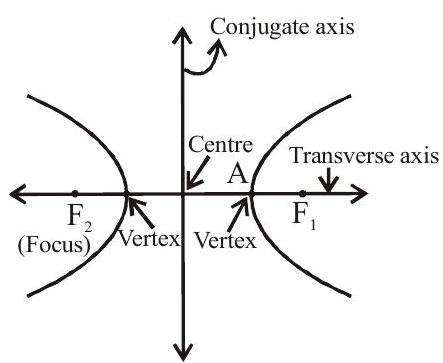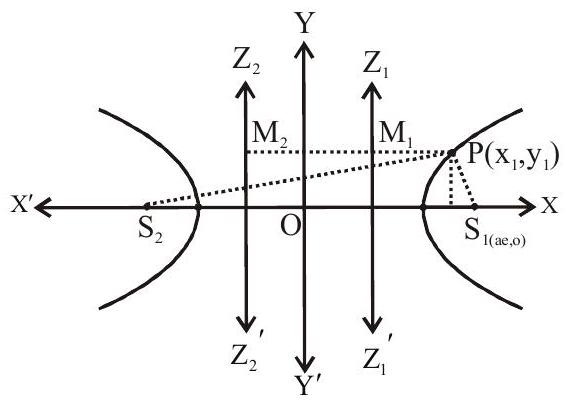HYPERBOLA-1 (Equation of Hyperbola)
Definition 1 : The locus of (a) point in (a) plane, the difference of whose distance from two fixed points in the plane is constant.
According to definition

Two fixed points are known as Foci of the hyperbola.
The mid point of the line segment joining the foci is called the centre. The line joining the vertices is known as transverse axis and the line through the centre and perpendicular to transverse axis is known as conjugate axis. The point at which the hyperbola intersect the transverse axis is known as vertices of the hyperbola.
Let distance between two foci be
Let (a) point

Definition 2: The locus of (a) point which moves in (a) plane such that the ratio of its distance from (a) fixed point to its perpendicular distance from (a) fixed straight line (not passing through given fixed point) is always constant and greater than 1 .
The equation of hyperbola whose focus is the point

Example: 1 Equation of hyperbola whose focus is
(a)
(b)
(c)
(d)
Show Answer
Solution:
Let variable point
Answer: (b)
Eccentricity
Some terms related to Hyperbola
Equation of hyperbola
1. Centre
All chords passing through (a) point and bisected at that point is known as centre of hyperbola
2. Eccentricity
3. Foci

4. Directrices
5. Vertices
6. Axes
The line AA’ is called transverse axis and the line perpendicular to its through the centre of the hyperbola is called conjugate axis. Equations of transverse axis is
Length of transverse axis
Length of conjugate
7. Double Ordinate
A chord of hyperbola which is perpendicular to transverse axis is known as double ordinate

8. Latus rectum
The double ordinates passing through focus is known as latus rectum.

9. Focal Chord
A chord passing through focus is known as focal chord.
10. Focal Distance

Rectangular or Equilateral Hyperbola
If
The eccentricity of rectangular hyperbola is
Equation of hyperbola if centre is (
Practice questions
1. The eccentricity of the conic
(a).
(b).
(c).
(d).
Show Answer
Answer: (c)2. The equation of the conic with focus at
(a).
(b).
(c).
(d).
Show Answer
Answer: (d)3. Equation of the hyperbola whose vertices are
(a).
(b).
(c).
(d).
Show Answer
Answer: (b)4. The eccentricity of the hyperbola whose latus rectum is half of its transverse axis, is
(a).
(b).
(c).
(d).
Show Answer
Answer: (a)5. The differences of the focal distances of any point on the hyperbola is equal to
(a). eccentricity
(b). latus-rectum
(c). length of conjugate axis
(d). length of transverse axis
Show Answer
Answer: (d)6. The distance between the foci of (a) hyperbola is 16 and its eccentricity is
(a).
(b).
(c).
(d).
Show Answer
Answer: (a)7. The length of latus rectum of the hyperbola
(a).
(b).
(c).
(d).
Show Answer
Answer: (d)8. The eccentricity of the hyperbola
(a).
(b).
(c).
(d).
Show Answer
Answer: (b)9. The foci of (a) hyperbola coincide with the foci of the ellipse
(a).
(b).
(c).
(d).
Show Answer
Answer: (c)10. The eccentricity of rectangular hyperbola is
(a).
(b).
(c).
(d).










